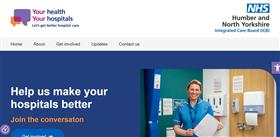| Welcome to our programme newsletter | Welcome to the latest edition of our newsletter, all about the Humber Acute Services programme. Here you'll find the latest news and updates about the programme, alongside information about how you can continue to get involved, share your ideas or ask questions.
This issue will provide an update on the decision by the Integrated Care Board about the next steps for the programme and explain the process of a consultation.
Let us know what you think and what you would like to see in the newsletter by emailing hasr@humberandnorthyorkshire.org.uk - we look forward to hearing from you. | | | Programme Update - June 2023 |
|
|
| Programme gets go ahead to move to next stage | Today, the Humber and North Yorkshire Integrated Care Board (HNY ICB) the body responsible for NHS planning and performance in our region – discussed a set of proposals for how services might look in the future. The Board praised the work undertaken to date and approved moving forward to public consultation on the proposals, subject to ratification by NHS England.
The consultation is expected to commence in September and run for around 12 weeks. It will be seeking views from anyone living or working in the Humber area or who uses local hospital services to help inform the ICB’s decision about the proposed changes. Decisions about the future shape of services will be made after the responses to the public consultation have been considered in full.
The proposals have been designed to enable the NHS to provide good quality care in the long-term and offer better, more sustainable hospital services for the region. They have been developed through a comprehensive process that has involved more than 12,000 people and been led by local doctors, nurses and other healthcare professionals across the Humber.
The proposals recommend retaining and improving the services available at local Emergency Departments in Grimsby, Scunthorpe and Hull and joining up better with services outside of hospital. Proposed improvements include increased availability of urgent care services for people with minor injuries and illnesses, enabling more people to be treated more quickly and helping to tackle long waiting times and ambulance handover delays.
Under the proposals, both Grimsby and Scunthorpe would continue to provide 24/7 Emergency Departments with comprehensive assessment, short-stay and same day emergency care services for adults and children attending through A&E.
To improve the sustainability of services and ensure all patients get the best outcomes, the proposals also recommend concentrating some specialist services, including trauma and overnight emergency surgery, in one hospital on the south bank of the Humber – Diana Princess of Wales Hospital, Grimsby. Bringing these more specialist services together at one hospital would improve the quality of care and help to make services more sustainable in the long run. Proposed changes would enable services meet key national standards such as providing 7-day consultant-led care.
These proposed changes are part of a much wider transformation of the NHS across the Humber and would help us to maximise the impact of recent investments such as the £58m million that was recently invested in new Emergency Departments at Grimsby and Scunthorpe and funding that has been secured to build new Community Diagnostics Centres in the region.
Details about the proposals and what they might mean for patients, staff, families and loved ones will be set out in detail during the public consultation to enable people to provide meaningful feedback. There will be lots of opportunities to get involved and share views.
More information on how people can have their say will be available closer to the consultation launch – if you want to hear about opportunities to get involved you can sign up here – Get Involved and find more information on our website: https://betterhospitalshumber.nhs.uk/
You can find copies of the Board papers and a recording of the meeting on the ICB website | | | How we are improving care outside of hospitals |
|
|
|
We caught up with Alex, Place Director for North Lincolnshire, and one of the leaders of the Humber Acute Services (HAS) Programme
|
|

|
Our plans to improve our hospitals for people who live in North Lincolnshire, North East Lincolnshire, East Riding and Hull are now taking shape.
To make sure these changes work properly, there will also need to be changes to health care outside hospital. We asked Alex Seale, NHS Place Director for North Lincolnshire with the Humber and North Yorkshire Integrated Care Board (ICB), to explain the benefits for staff and patients.
“If people need specialist treatment, they want to be in hospital,” she says. “But for routine things, such as giving a blood sample, they want to be closer to home.
“To enable us to deliver the changes we are proposing to our hospitals, we need a stronger model for out of hospital care. We call it our Home First approach.”
Home First looks at all of a patient’s health needs and works across all locations and services to ensure those needs are met. “Too often healthcare can be a little bit compartmentalised because we’re only looking at one aspect of a person’s care,” says Alex.
Commissioners have been looking at new ways of working, new models of care, and ways to use modern technology, to make delivering care beyond the hospital walls much easier. The Virtual Wards programme allows people who’ve had some time in hospital and are ready to go home, but still need a bit more care, to have that care in their own home. Along with other innovative approaches, it means that more care that is currently provided in hospital can be delivered in or close to people’s homes.
Alex acknowledges that not everybody is comfortable with new technology: “It’s really important to take into consideration digital inclusion. For some people it’s their preferred option. Some either don’t feel comfortable with technology, or don’t have a smart phone, or tablet – so it is important that we recognise that and put in place alternatives that work for them.”
“We’re also developing services to make greater use of diagnostic tests in community care – so again people can avoid going to hospital,” says Alex.
“We are developing networks so that, for example, a patient’s GP and hospital consultant can work together to decide whether a patient actually need to go to the hospital or whether they can be cared for at home. Very often outpatient consultations don’t need to be face-to-face. And if we can provide an alternative that saves people travelling to a hospital, finding transport or a parking space, it’s better for the patient and better for staff.”
For patients who have had hospital treatment, ‘patient-initiated follow up’ helps cut down further hospital visits. Instead of automatically coming to hospital in six months to tell the consultant you are fine, patients are given advice on what to watch for in their daily health which may need a hospital visit, or an online consultation.
“We want to introduce ‘anticipatory services’ to prevent problems and keep people out of hospital. The falls prevention work is a good example of this, whereby a community team will visit someone at home, advise on trip hazards and give people exercises they can do at home to build up their strength.”
Again, we want to focus on providing alternatives to having to go to hospital. For example, there is a single point of advice available to health professionals. If an ambulance is called out to someone who has had a fall, they can check if they need to go into hospital. GPs and nurses can give advice over the telephone or online, or if necessary, visit a patient at home, and if needed, an urgent community response team can respond within two hours. This kind of coordinated approach can safely keep people out of hospital and at home.
“It’s about joining up health and care,” says Alex. “We work closely with care homes, enhancing health care in care homes, to avoid people having to go into hospital. And we work very closely with our colleagues in local authorities.
“It’s about providing our patients with effective, joined-up support.”
It’s not just about services for frail elderly people: “We have been successfully piloting Hospital at Home for children too”, says Alex. “Children who need hospital care can have some of this care at home, helping them to get home sooner or avoid going to hospital at all. This is so much better for children and their families.”
So, what will this mean for staff? “We are looking at how we can develop new roles between health and care,” says Alex. “When people are getting care at home, they may have had lots of different people coming in which can be confusing. With our joined-up approach, we can we upskill our staff to provide a range of services, so that our patients don’t have to deal with lots of different people.”
We believe, that more integrated working could lead to more interesting roles working across hospital and community settings. So, a radiographer might work sometimes in hospital, and other times be out in the community.
The focus, Alex explains, is on an integrated, community approach that helps people avoid coming into hospital, but when they have to, we want to get them home as fast as possible “We know if people are stuck in a bed it takes only days to lose muscle mass and then people start to lose mobility and independence.
“Home is the best place for people – with an integrated response in place to support them.”
|
|
|
| Explaining a consultation |
|
|

|
|
What is a Formal Public Consultation on Service Change and what will happen next?
|
|
The NHS regularly engages with and listens to the public, patients and staff through various mechanisms. We do this because services work better when they take into account the needs and preferences of those who use them and who work in them. NHS organisations also have a legal duty to involve the public when it is making decisions about possible changes to services and how they are provided.
The “Duty to Involve” dates back to the NHS Act 2006 and continues to apply to NHS organisations who involve the public in lots of different ways, including through elected representatives in local councils. When changes that are considered to be substantial are being proposed, the duty to involve takes the form of formal public consultation.
Consultation is typically led by the NHS organisation which commissions the service. In the case of hospital services in the Humber, that is the NHS Humber and North Yorkshire Integrated Care Board (ICB). In addition, the relevant local authorities are required to form a joint committee which scrutinises the decisions made by the NHS about services which are used by their residents. Scrutiny committees also have legal roles in consultations.
Consultation is a structured process that allows individuals, communities, staff and other interested parties to provide their opinions and feedback on proposed changes. It ensures that decision-making is inclusive and takes into account the needs and preferences of those who might be impacted by any changes.
Consultation is not a referendum. Decision-makers are required to consider all viewpoints that are raised, not just those with the most support. Consultation is about finding out what people think about proposed changes and, importantly, how they might be impacted by them. It is also about working with people to consider what could be done to mitigate any negative impact of change and explore potential ideas that might not have been considered before.
To make involvement opportunities as open as possible, the NHS uses many different methods to engage with the public during the consultation process. This may include public meetings or exhibitions, questionnaires, meetings with local groups representing patients, service users or people with specific health needs or interviews with identified representatives or groups who might typically be harder to hear from.
During a consultation, the NHS will provide information about the proposed changes and the alternative ideas that were also considered, explaining why the proposed options have been put forward, what the benefits of the changes would be and how they might impact local people. The NHS also gathers feedback from local people. Decisions must not be taken until feedback has been properly taken into consideration.
It is free to participate in a public consultation. You can attend a public meeting or event (either in the room or online), complete the questionnaire or provide feedback by letter, email or phone. You will be able to provide feedback in a range of ways, giving you the opportunity to highlight any concerns, suggestions, or even put forward alternative solutions.
After the formal public consultation period ends, which is usually around 12 weeks, the NHS will carefully consider all the feedback received, evaluate the responses, and make decisions in the best interests of patients.
After these decisions are made, the outcomes of the consultation will be communicated to the public, along with an explanation of how the feedback influenced the decision-making process.
You can sign up to hear about our proposed consultation when it opens later this year through our website: https://betterhospitalshumber.nhs.uk/
|
|
|
|
We are developing a new programme website...
|
|

|
As well as a revamped newsletter, we have a new website where people can find the information they need to take part in our Consultation when it launches later this year.
By visiting the website people can:
- find out about local events and opportunities to have their say during the consultation.
- sign up to receive information or get involved in an event
- ask questions and get answers
- complete our consultation questionnaire
- tell us about what they think about the proposals.
The website will develop as we move closer to consultation, so please let us know what you think we can improve.
|
|
|
| Ask a Question! | | You can ask us a question or get in touch with us anytime by clicking here or the banner above! | |
|